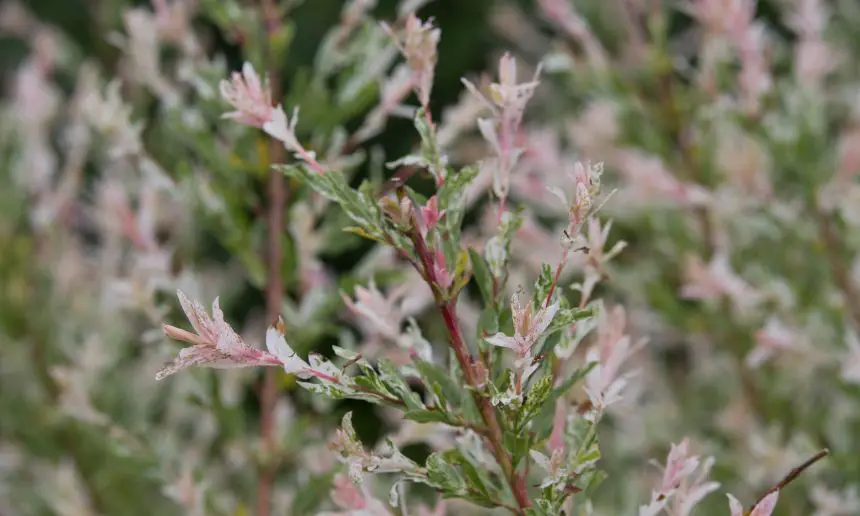Salix Flamingo Tree Dying? 3 Reasons+Solutions
Salix Flamingo, also known as shrimp willow, is one of the most popular garden plants, mainly due to its flamboyant foliage and relatively easy maintenance.
It’s a dwarf type of willow that looks equally good potted on the patio and planted in the garden.
This is particularly true in the springtime when the Salix Flamingo is at its most beautiful, with gorgeous green and white leaves, with flamingo-pink tips, which is how it got its name.
For some, it’s even more stunning later in the year, in autumn, when the color of the tree turns bronze and orange, as the leaves start to fall off.
While it’s fairly easy to care for, this plant is still susceptible to some issues, which can even lead to the Salix Flamingo tree dying.
There are several reasons why a Salix Flamingo tree may be dying, ranging from environmental factors to pests and diseases.
Identifying the underlying cause of the problem is crucial to providing the right treatment and saving your tree.
Below. I’ll dig deeper into why this happens and what can you do to prevent it and revive the dying plant.
Table of Contents
Salix Flamingo Tree Dying – Reasons And How To Save It
To know that your Salix Flamingo is dying and that it needs help, you first have to learn how to recognize the symptoms of its decline and identify the reason why the plant is unwell.
The most common causes of dying Salix Flamingo include root rot, underwatering, and bacterial and fungal diseases such as willow scab or powder mildew.
In most cases, the first signs of distress will be the change in the leaves color, as they will start to turn brown.
Other symptoms may include a powdery substance covering the leaves or the severely stunted growth of the entire plant.
Whatever the reason for your Salix Flamingo tree dying is, it’s important to act quickly, as it will provide the opportunity to prevent more serious damage to the plant.
Below; I’ll explain each potential cause in more detail and share a few tips on how to revive a dying Salix Flamingo.

Underwatering
Salix Flamingo is known as a very thirsty plant, that enjoys and thrives in moist soil. Otherwise, the plant will experience severe damage and potentially die.
Underwatering Salix Flamingo will result in its leaves turning brown, curling, and feeling brittle to the touch.
Also, the rootball will become dry and won’t be able to provide soil nutrients for the plant.
As the leaves turn bad, they will lose the ability to do their part in photosynthesis and if the Salix Flamingo is left without water for a longer period of time, it may eventually die.
How to Save the Plant?
[amazon box=”B07NQLZB2T”]
The best way to deal with underwatering is to make sure that it never occurs, by regularly watering your Salix Flamingo, especially when the weather is hot or particularly windy.
Make sure that the topsoil is never fully dry.
Still, even if you notice that your plant is underwatered, a timely reaction should be able to revive it pretty quickly.
If your Salix Flamingo is potted, dip the entire pot in the water for a few hours.
This should revive the dry rootball and, soon, the whole plant will perk up and regain its healthy look.
In case the lack of water has caused the leaves to turn brow, you may prune all the affected branches to make sure none of the much-needed nutrients go into the vane.
Powdery Mildew
Powdery Mildew is a common problem for thousands of plants, and salix flamingo tree is no different.
The good news is that this fungal disease is rather easy to identify.
The infected salix flamingo will have a powdery white substance, similar to mildew covering its leaves.
Obviously, this is how this disease got its name.
How to Save the Plant?
[amazon box=”B000UJVDXY”]
Luckily, powdery mildew is rather easy to deal with. The trick is to kill off the mold spores while avoiding any damage to the leaves.
You can do this with the mouthwash, the same one you probably use every day.
Simply wiping the affected area with the mouthwash should remove all powdery mildew spores.
Another thing you can do is spray the plant with the homemade fungicide which you can create by mixing 1 tablespoon of baking soda and 1 teaspoon of liquid dish detergent in a gallon of water.
Willow Scab
Willow scab is a fungal disease that is rather common for Salix Flamingos and commonly appears in the spring when the weather is wet.
When the plant is infected with this disease, its leaves will lose their color and you’ll notice brown spots on their surface.
After a while, the leaves will wilt and fall off.
You can identify willow scabs as the cause of your Salix Flamingo dying by olive-brown spores that gather at the base of the leaf.
So make sure to regularly check the leaves for traces of this disease.
How to Save the Plant?
While willow scab will rarely lead to Salix Flamingo dying, repeated infections will stunt the plant’s growth.
Therefore, it’s important to manage the disease to avoid more severe damage. This can be done by combining good cultural practices and fungicide applications.
The first thing to do is to prune all the areas infected by the willow scab.
Make sure to trim all the infected branches and twigs, and sterilize pruning tools after each session, to avoid the unintentional spread of the infection.
You can use water and bleach solution for this. All the remaining fungus can be killed off with fungicide.
While fungicide may not be necessary for dealing with willow scab, in case of more severe fungal diseases, such as black canker, it’s essential.
Conclusion
Salix Flamingo is a rather hardy plant and fairly resistant to most common plant diseases. This makes it very beginner-friendly and is a great plant to start your gardening adventure with.
However, this doesn’t mean that it requires no care at all.
You should always look to provide your Salix Flamingo with plenty of water, expose it to enough sunlight, and carefully monitor for any potential signs of infections.
These steps alone should be more than enough to keep your plant healthy and promote its normal growth.
Even if you run into some of the problems that are common for Salix Flamingos, such as underwatering or fungal diseases, the timely reaction will likely prevent the issue from spreading and revive the plant, helping it regain its vigor.




